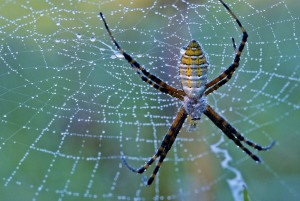 Spiders are not likely to make many “favorite animals” list. They are the cause of one of the most common phobias in our society which is not hard to explain given their prevalence in popular literature and entertainment.
Spiders are not likely to make many “favorite animals” list. They are the cause of one of the most common phobias in our society which is not hard to explain given their prevalence in popular literature and entertainment.
But much of what we think we know about spiders is actually wrong, based merely on myths and misunderstandings that have been passed along for generations.
Here are some of the most common myths debunked.  1. Daddy-long-legs are NOT spiders. Like insects, they are related to spiders but unlike spiders they have only ONE body part. In addition, they don’t make silk, have venom or fangs. Daddy-long-legs are in a group of animals called Harvestmen. (To read more on this, Click HERE.)
1. Daddy-long-legs are NOT spiders. Like insects, they are related to spiders but unlike spiders they have only ONE body part. In addition, they don’t make silk, have venom or fangs. Daddy-long-legs are in a group of animals called Harvestmen. (To read more on this, Click HERE.)
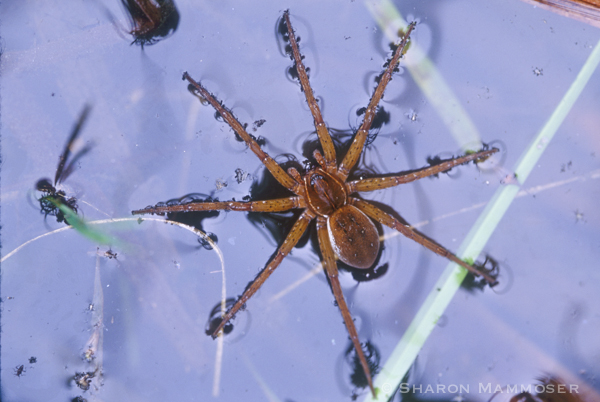
2 Spiders RARELY BITE– not because they can’t, but because they don’t–to them humans are not viewed as prey and will not bite when contact is made. Touching a spider or getting one on you will not make it bite you! Spiders may bite if they feel threatened or to protect their egg sac, but not simply because they make contact. Most of those “mystery” bites that are often attributed to spiders are not from spiders at all. Oddly enough, this myth is perpetuated regularly by the medical professionals who usually have no specific spider training and simply repeat what they’ve heard, which, often times, is nothing more than myths.

3.All spiders do NOT build webs. There are many different species of spiders that do not build silken traps to catch their prey. Many stalk their prey like a wolf or wait motionless until something comes along.
4 Spiders are NOT insects though they are related to insects. Insects and spiders are Arthropods, meaning they have a hard exoskeleton, segmented body and jointed appendages. Insects are characterized by having three body parts, three pairs of legs, one pair of antennae and one or two pairs of wings. 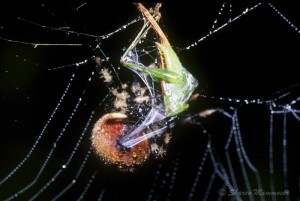 Spiders on the other hand have only two body parts, along with 4 pairs of legs. Spiders also have an organ on the underside of their body called a spinneret which produces silk the spider uses in a variety of ways, including as a drag line, for a web, to surround its eggs or even as a chamber to protect itself from predators. Most spiders have 8 eyes.
Spiders on the other hand have only two body parts, along with 4 pairs of legs. Spiders also have an organ on the underside of their body called a spinneret which produces silk the spider uses in a variety of ways, including as a drag line, for a web, to surround its eggs or even as a chamber to protect itself from predators. Most spiders have 8 eyes.
5.Nearly all spiders are venomous but none are poisonous. Of the over 100 families of spiders, just two lack venom glands. However, it needs to be said that venomous and poisonous are NOT the same thing! Poisonous means the animal or plant produces a poison, that when taken into the body, or ingested, causes illness or death. Some mushrooms or berries are poisonous. Venomous animals on the other hand, produce a venom that when injected into the prey, may cause illness or death. Spiders have venom solely so they can subdue prey, not so they can bite humans. Their venom usually has little effect on humans, who are much, much larger in size. 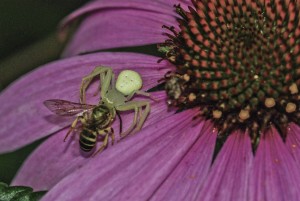
6.Spider webs are NOT always round. There are many differently shaped webs including funnels, sheets, and cobwebs. Each spider species that makes a web, has its own unique shape.
7.Spiders eat their prey. It is not true that they simply “suck the juices.”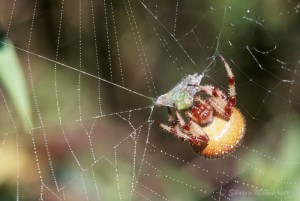
8.Spiders are NOT easy to identify. This might be one of the most common myths out there! Scientists have named more than 50,ooo named species of spiders though they estimate that this is only 10% of all that exist. Many have simply not been discovered or named. It is VERY difficult to identify spiders–and people who do this, use a combination of things, including eye arrangement of the spiders, body shape and a microscope–the latter of which is often crucial to identification.
With this many different species, identification is extremely difficult. A microscope is often needed. Identification books exist, often basing id on the arrangement of the eyes but this is far from complete.
9.Tarantulas are not the deadly spiders movies make them out to be. The venom in these large spiders has a low toxicity to humans. Tarantulas do have hairs on their abdomens that they can raise to irritate the skin of someone or something threatening them.
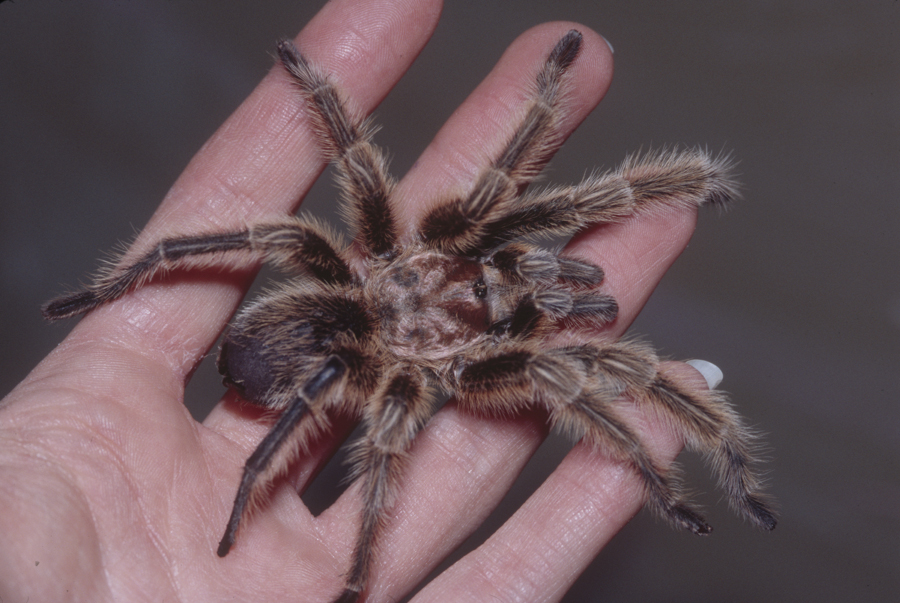
10.Brown recluse spiders are difficult to identify and are not found everywhere in the United States. While it is true that brown recluses have a violin-shape on their bodies, just behind their eyes, this is not a reliable method of identification as there are many other spiders that have a similar shape on their bodies. Many of the bites attributed to brown recluses, even by medical professionals, come from areas where brown recluses don’t inhabitant. Often an unidentified bite is automatically attributed to a spider, even though spiders rarely bite. Check out the Brown recluse territory map taken from Rod Crawford at the Burke Museum in Seattle, Washington, to see if Brown Recluses live in your part of the country.
To learn more, visit the Burke Museum’s website and the pages dedicated to dispelling spider myths which were written by Rod Crawford,Curator of Arachnids. He has been studying spiders for 40 years!
Read about how I overcame my fear of spiders. Click here or check out some of my favorite spider pictures, HERE.
References:
The Burke Museum’s website written by Rod Crawford, Curator of Arachnids.
The Book of Spiders by Rod Preston-Mafham, published by Chartwell Books Inc, in 1991

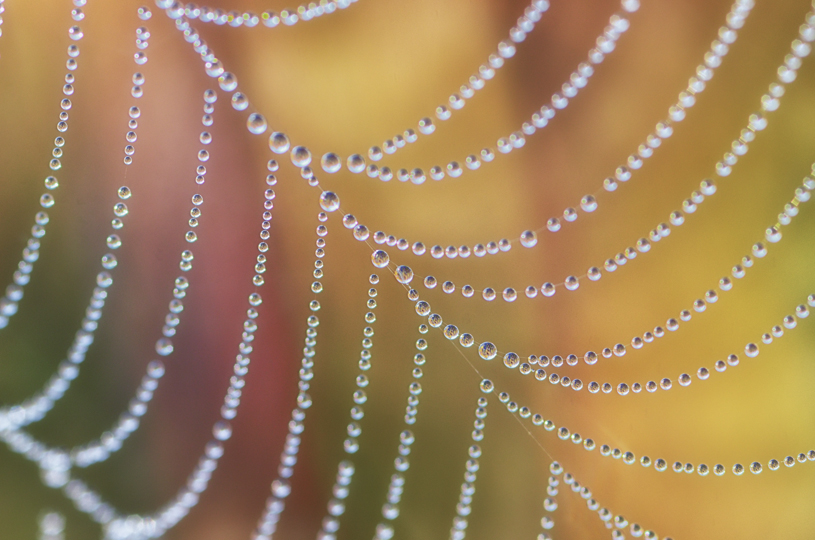
Attractive section of content. I just stumbled upon your weblog and in accession capital to
assert that I acquire in fact enjoyed account your blog posts.
Anyway I will be subscribing to your augment and even I achievement you access consistently quickly.
Thanks for your marvelous posting! I definitely
enjoyed reading it, you may be a great author.I will make
sure to bookmark your blog and may come back later on.
I want to encourage yourself to continue your great work, have a nice morning!
This is the right site for anyone who really wants to understand this topic.
You understand a whole lot its almost hard
to argue with you (not that I personally would want to…HaHa).
You definitely put a brand new spin on a subject that’s been discussed for many years.
Great stuff, just excellent!
Amazing blog! Do you have any tips and hints for aspiring writers?
I’m planning to start my own blog soon but I’m a little lost on everything.
Would you recommend starting with a free platform
like WordPress or go for a paid option? There are so many choices out there that
I’m totally overwhelmed .. Any suggestions?
Bless you!
Hello and thanks for the compliments. I am new to blogging and am learning as I go so definitely not an expert! I am using the paid option so I can have my site without all the other letters that are attached to the free one. I think the best tip I can give is to what about what you love and make time for it in your daily schedule. Sometimes making time is challenging, but it is worth it. I found this website helpful: http://michaelhyatt.com/ez-wordpress-setup.html Also, there are lots of great on line word press tutorials that were super helpful to me; maybe you can check some of them out. Good luck!
Good day I am so glad I found your website, I really found you
by accident, while I was researching on Google for something else, Anyhow I am here now and would just like to say thanks a lot for a
marvelous post and a all round interesting blog (I also love the theme/design),
I don’t have time to read through it all at the minute but I
have saved it and also added in your RSS feeds, so when I have time I will be back to read more,
Please do keep up the great b.
Hello to you. I very much appreciate the positive feedback; thanks for taking time to write.
Good day! I just want to give you a huge thumbs up for your great information you
have here on this post. I am returning to your web site for more soon.
Wow, thanks so much for writing. I will check out your blog soon!
Thanks for writing. I will consider changing the layout.
Thanks for taking the time to write. I am new to this blogging platform and have much to learn. I will look into the problem you suggested and see if I can fix/figure it out.
Hi there, Yes I have thought about both publishing an ebook and authoring on other blogs, I just haven’t investigated the details of doing either. Let me know when I could be involved.
Hello there! This is my first visit to your blog! We are a group of
volunteers and starting a new project in a community in the same niche.
Your blog provided us valuable information to work on. You have
done a outstanding job!
Thank you for your kind comments. I wish you good luck in your project.
Good day! Do you use Twitter? I’d like to follow you if that would be ok.
I’m absolutely enjoying your blog and look forward to new
updates.
I don’t currently use Twitter but would like to in the future…will let you know if that happens. Thanks for the note!
Thank you for the nice comment. Happy day to you!
Hi there, thanks so much for the positive comments. I hope to see you again soon.